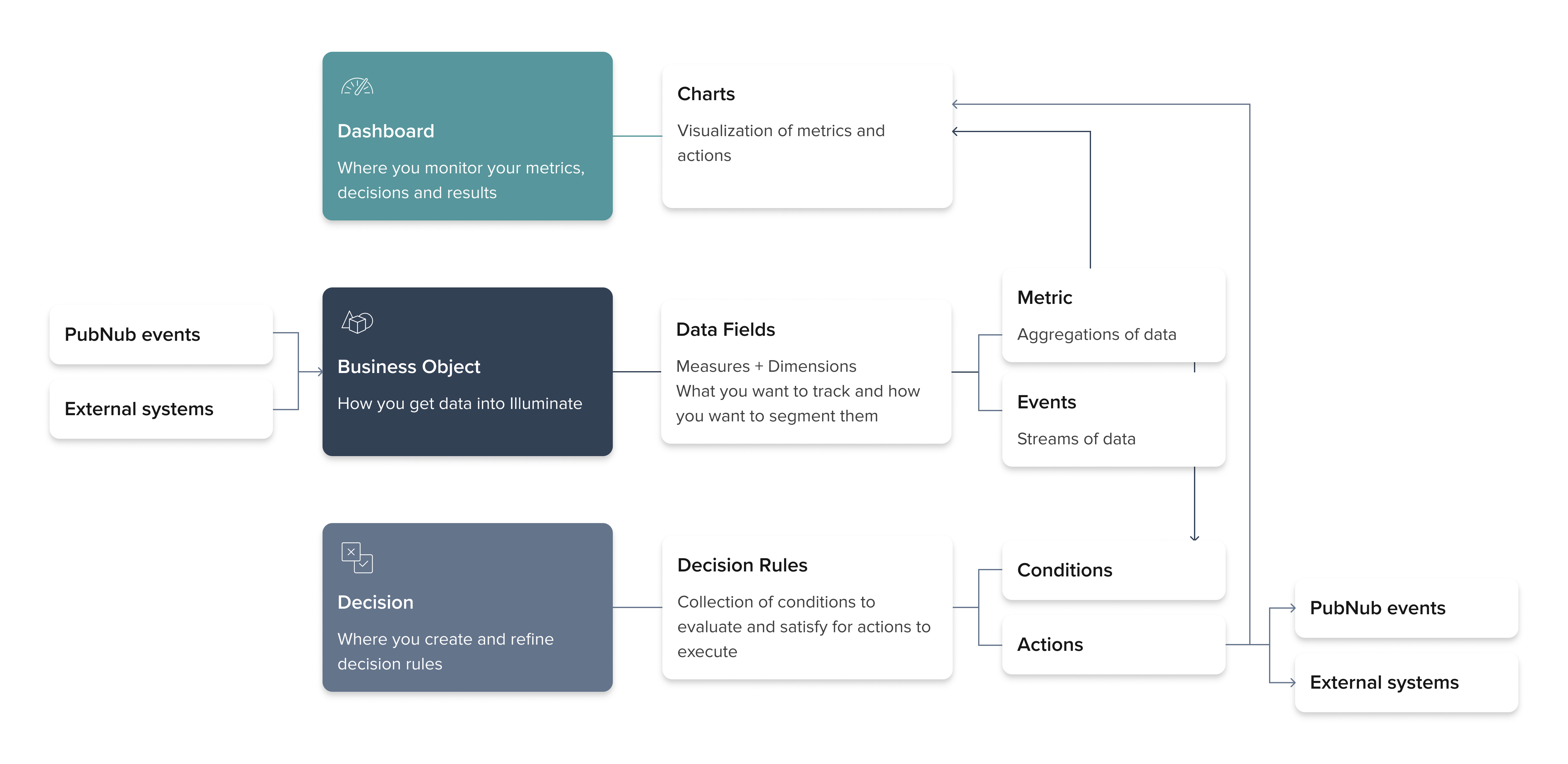PubNub Illuminate
PubNub Illuminate is a real-time decisioning and analytics product that is customizable to an organization’s unique use case.
The product is designed with the product managers and analysts in mind, allowing them to do the following:
- Define custom real-time aggregated metrics.
- Set up and deploy decision rules with conditions and actions.
- Immediately visualize the metrics you’re tracking, the actions executed, and their outcome.
You can do all this in real time without pulling your engineering team away from their ongoing projects.
Availability
Illuminate can be used with any real-time interactive app, whether or not PubNub powers it. It is available for everyone on a two-week free trial basis. After these two trial weeks, you can contact sales to upgrade your plan and continue to have Illuminate access.
If your real-time app is not powered by PubNub, your data can be sent using the PubNub's Fire API.
Access
You can access Illuminate through Admin Portal. Once you log in, click Dashboards, Business Objects, or Decisions under the Illuminate module on the left sidebar.
Public Admin Portal demo
Want to browse through the Admin Portal without creating an account? Explore it through the Public Demo that shows examples of most PubNub features for transport and logistics use case.
Building blocks
Illuminate consists of these three modules:
- Business Object – how you get data into Illuminate. Business Objects are containers for capturing data from the selected apps and keysets. You can add and define (data fields, create metrics) with the desired aggregation, and activate Business Objects to start the data capture process.
- Decision – where you take action on the metrics you’ve created. You can do that by defining rules with conditions to be met, and actions triggered whenever these rules are met.
- Dashboard – where you visualize the metrics you’ve created in Business Objects and actions executed in Decisions through charts and dashboards (collections of charts).

Get started
If this is your first time using Illuminate, start with Business Objects to define and capture the data you need. Then, use the Business Object created to make Decisions and/or visualize the data through Dashboards.
Who uses Illuminate
Illuminate is meant to serve three types of personas, although all actions can be performed by one person or a few collaborating asynchronously:
- Users who are responsible for growth and revenue. They need to understand what's happening in real time, make decisions based on the data they see, and execute them. Usually, they are Growth or Product Managers, Product Strategy Managers, or Product Directors.
- Users who help others with data analysis and translate product data requirements into technical requirements for implementing data measuring points. Typically, they are Business Analysts, Data Scientists, or Business Intelligence Engineers.
- Users who implement product features and support the application's technical development. Usually, they are Software Engineers, Tech Leads, or Technical Directors.
Sample use case
Illuminate helps make data-backed decisions across various industries in many types of use cases.
Examples:
- Multi-user collaboration (Gaming): Targeted monetization experiments
- Live audience engagement (Live events): Personalized recommendations, promotions, or rewards
- Data streaming (Transport, delivery, and logistics): Asset tracking
- Device control (IoT): Alerts and warnings
Throughout this set of documents, we will guide you through the features of Illuminate using an end-to-end gaming scenario in which two guilds compete with each other in a game.
The company wants to perform an experiment in which they award the guilds that engage in the game (through the number of messages sent) by sending them discounts for purchase items in their online store. By observing the results of this experiment, the company wants to see if the discounts sent for engagement impact the company’s revenue and increase the number of items sold.
For this scenario, we will set up the following:
- Business Object that collects the data we want to measure. We’ll create metrics that aggregate that data in a way that's consistent for both visualizations and decisions. For our scenario, we’ll capture the guild name, sent message, purchase item, and purchase item value as data fields (measures and dimensions). Then, we’ll create two metrics that sum up the number of messages a given guild sends and the value of purchased items.
- Decision that defines conditions to evaluate and actions to take when conditions are met. For our scenario, we want to send a discount to a guild that sends 100 or more messages over 30 minutes.
- Dashboard to visualize the metric data and triggered actions and to monitor them in real time.
For our scenario, we want to create a Dashboard with two charts.
- One chart will display the number of sent messages and see when the discount is sent to a guild that reaches or exceeds the 100-message sum threshold.
- The other chart will show the revenue over time. This way, you can compare if discounts sent to guild members impacted your revenue.